That Useful Wine Site
Search, or just roll your cursor over the colored boxes farther below.click the “x” to dismiss Search-results block.
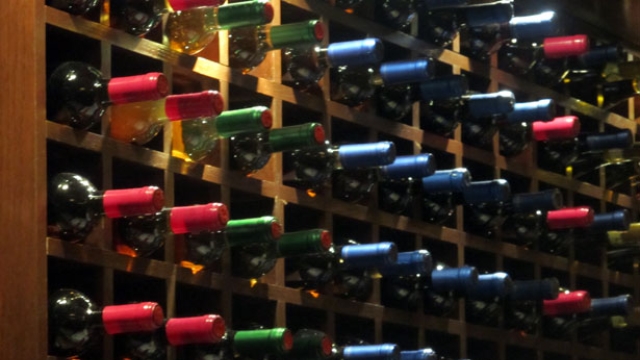
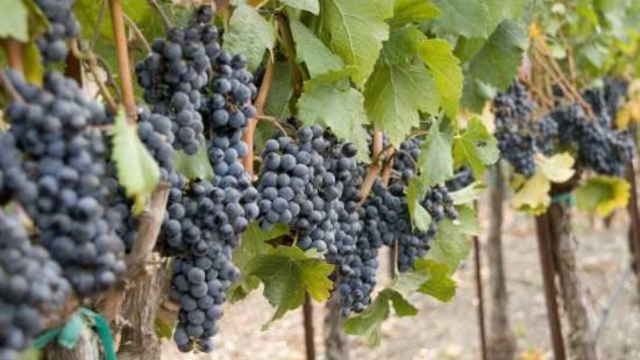
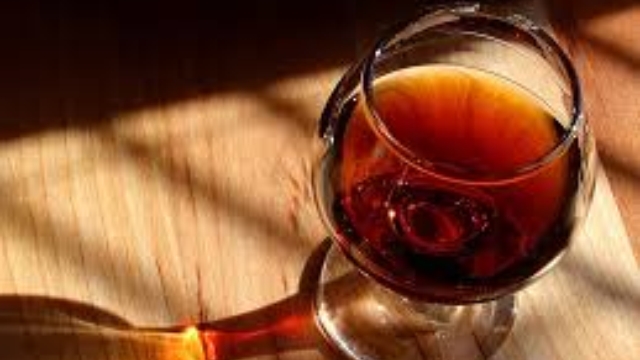
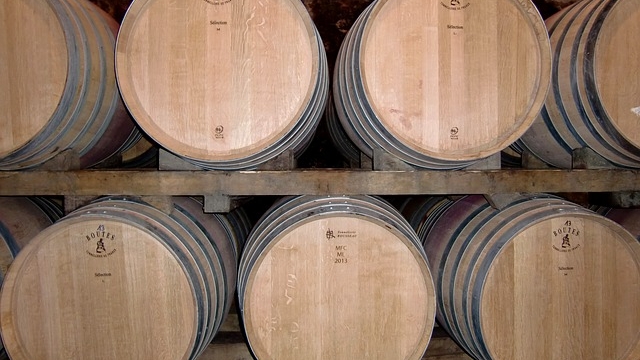
Advertisement:
Advertisement:
Quick page jumps:
(Synonyms: Bálint, Gros Rhin, Grüner Silvaner, Grüner Zierfandler, Johannisberg, Österreicher, Österreichisch, Roter Silvaner, Salfin, Silvain Vert, Silvanic Zeleni, Silvánske Zelené, Sylnaver, Sylvaner Verde, Sylvanske Zelené, Zeleni Silvanec, Zierfandi, Zöld Szilváni)
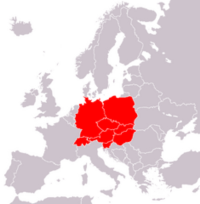
Silvaner (also quite commonly spelled “Sylvaner”) is a very old white-wine grape originating in central Europe, most likely in Transylvania; it is today grown throughout central Europe, most notably in Germany (especially Franconia) and Alsace, but also to some extent in Austria, Switzerland, Croatia, and Slovakia, plus Romania (which today includes the former Transylvania). There have been some experiments in the New World, but little is now grown there.
In Germany, the grape’s official name is “Grüner Silvaner”; the spelling “Sylvaner” is generally used in Alsace, Switzerland, and Austria, but is very common elsewhere as well (Wikipedia’s article is headed “Silvaner” but uses “Sylvaner” throughout its text).
Silvaner at its best can produce top-quality wines that can go head to head against the greatest white, Riesling; unfortunately, it is not commonly at its best, because the grape’s natural vigor coupled with its innately neutral taste easily lead producers to grow it for inexpensive bulk wines. (Great amounts of it go into the bland, fungible Liebfraumilch bottlings once so popular as “cheap wine”.) But that same neutrality that leads to blandness when vinification is casual also allows dedicated, careful winemakers to express a good deal of terroir. In Alsace, whose Sylvaners are usually rather simple renditions of the grape, there is one large vineyard (Zotzenberg) whose Sylvaner has special dispensation to be used in Alsace Grand Cru wines.
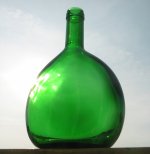
Silvaner wines from the Franconia region of Germany are still typically bottled in the classic Bocksbeutel (shown at the right), though there is a (much regretted) slowly increasing movement away from the shape owing to the difficulties it imposes on long-distance shipping and retail distribution.
Silvaner has, like all the better regional white-wine grapes, a naturally high acidity; in consequence, wines from it will age quite well—but there is also the classic vineyard conundrum of trying to balance off flavor against alcohol content, since the grapes are also naturally high in sugars (so that as they ripen, the flavor increases, but so also does the potential alchohol content of the resultant wine). As with so many other grapes like that (Riesling, Gewürztraminer, Scheurebe, and so on), Silvaner is thus often made into an off-dry or dessert wine by stopping the fermentation before it is complete (leaving “residual sugars” in the wine).
The keys to high-quality Silvaner seem to be these: appropriate soils and vineyard location; keeping yields low; and care in harvesting at the optimum moment. Mind, those are qualities needful for any good wine, but they seem especially important with Silvaner, which in modern times was badly overcropped for those cheap bulk wines, thus tarnishing the variety’s image. When well made, it has a neutral to slightly floral nose, sharp acidity, notable minerality, and a quality often described as “earthiness”.
Factoid: In Alsace, Zotzenberg vineyard “Grand Cru” wines may by law consist of Gewürztraminer, Pinot Gris, Riesling, and Sylvaner in any combination. Thus, one could produce a 100% varietal “Sylvaner Grand Cru” from that vineyard—but it could not legally be labelled as such, but rather just “Zotzenberg Grand Cru”.
The list of reasonable candidate bottlings for this varioety is steadily shrinking, between falling evaluations, rising prices, and shrinking market availability. What we show below is about it, even flexing our parameters a bit.
• This wine’s Wine Searcher “Reviews” page.
• This wine’s CellarTracker review pages.
• Retail offers of this wine listed by Wine Searcher.
• Retail offers of this wine listed by 1000 Corks.
• This wine’s Wine Searcher “Reviews” page.
• This wine’s CellarTracker review pages.
• Retail offers of this wine listed by Wine Searcher.
• Retail offers of this wine listed by 1000 Corks.
We found no Silvaner enough better than those listed above as to justify a “splurge” price.
Advertisement:
Advertisement:
|
|
This site is one of The Owlcroft Company family of web sites. Please click on the link (or the owl) to see a menu of our other diverse user-friendly, helpful sites. |
|
| (Note: All Owlcroft systems run on Ubuntu Linux and we heartily recommend it to everyone—click on the link for more information). | ||
|
All content copyright © 2024 The Owlcroft Company
(excepting quoted material, which is believed to be Fair Use). |
This web page is strictly compliant with the W3C (World Wide Web Consortium) Extensible HyperText Markup Language (XHTML) Protocol v1.0 (Transitional) and the W3C Cascading Style Sheets (CSS) Protocol v3 — because we care about interoperability. Click on the logos below to test us!
This page was last modified on Saturday, 30 October 2021, at 11:26 pm Pacific Time.
Some Descriptions of Silvaner Wines
“This dichotomy is explained by the vigour of the Sylvaner vine and the grape’s neutral flavour, which can lead to blandness unless yields are controlled. On the other hand it gives a blank canvas for the expression of terroir, and on good sites with skilled winemaking, Sylvaner can produce elegant wines. It has high acidity but naturally reaches high must weights, so is often blended with other varieties such as Riesling or Elbling, and is sometimes made into a dessert wine…[O]n the best chalky Muschelkalk terroir it can produce wines that can compete with the best German white wines which usually are made out of the Riesling grape. These powerful wines are considered food-friendly and are often described as having an ‘earthy’ palate.”
@ Silvaner:
“The wines it produces are high in acidity and not particularly marked by flavour or longevity, but in the right spot, such as particular sites in Franken and Rheinhessen, it can produce extremely racy, excitingly sleek, sometimes earthy wines that can age well.”
@ Sylvaner:
“Silvaner is one of Germany’s few white wine grapes that seems obviously most at home producing dry rather than fruitier styles of wine, and so could be said to be particularly in tune with current tastes among wine drinkers in Germany. Franken Silvaners may not be the most aromatic wines but, perhaps thanks to the clay-limestone soils there, have a special, sometimes mineral, raciness as well as very firm, full body. To perform well here the frost-prone Silvaner needs a good site and that from the Würzburger Stein vineyard has a long-established reputation. It is still revered at Castell and can make lovely wines on the Steigerwald slopes near Iphofen.”
“When Silvaner is done right, with proper pruning and limited yields, it produces drier, crisper, more acidic wines with aromas and flavors of citrus peel, almond, green apple, and pineapple. Alsatian Silvaners tend to be even drier than their German cousins, and because of their high acidity and dryness, Silvaners are often blended with Rieslings, Elbling, Gewürztraminers and other German and Alsatian grapes that tend to lean toward the sweeter side…[W]ell-produced Silvaners (those with low yields from their vines) will give off very fresh scents of green apple and lemon curd. With some wines, you might get a nose of sugar cane while with others, more of a sea salt/sea breeze scent. These particular smells come down to location of the vineyard and where the wine was produced. Either way, though, you’ll be able to tell from the very first sniff that these wines are dry and tart and unlike other German varietals you might have tasted. Because of their high acidity and low alcohol levels, Silvaners can sometimes taste a little on the thin side. However, the well-produced Silvaners will be very dry wines, much drier than anything else produced in Germany; Alsatian Silvaners will be even drier, bone dry. Silvaners typically have a lot of flavor right up front during each sip (called the attack) but then thin out or give way as the wine makes its way down your tongue and throat. Despite this, Silvaners can have decent length to them; it’s in the middle that they kind of fall apart. Green apple flavors will abound along with a lot of dry citrus and perhaps some of that salty flavor you smelled earlier (though it will be more like club soda than straight salt. You might even detect a hint of bitterness to the wine also, as if you’ve encountered a citrus seed or part of a peel. Some Silvaners will also greet you in the middle or at the end with a hint of sweetness as well.”
“Some of the world’s finest Silvaner wines comes from Germany’s otherwise undistinguished Franken [Franconia] region. It is significant that Franken is the only Germany wine region where Riesling does not figure among the varieties of note. The clay-limestone soils here give its Silvaner wines substantial structure and body, while the cool climate helps prevent acidity levels from dropping too low. The famous Wurzburger Stein vineyard in Wurzburg is a great example of a location where Silvaner outperforms Riesling. The classic Wurzburger Stein Silvaner is a well-rounded wine with impressive minerality, faint herbal notes and a hint of citrus and melon. Silvaner is one of few varieties able to ripen fully in Franken, and is capable of achieving sufficient must-weights to be sold as Prädikatswein. In Alsace, Sylvaner wines have distinctively full-bodied style with a whiff of earth and smoke on the nose, highlighted at the expense of the scant fruit flavors the variety manages to muster. Some of the finest examples come from Alsace’s Grand Cru sites, although most cannot be labeled “Grand Cru” because the variety is almost entirely excluded by Alsace’s Grand Cru appellation laws. Only one Alsace Grand Cru vineyard—Zotzenberg—is officially permitted to use Sylvaner in its wines…Italian and Swiss Silvaners are typically much lighter and crisper than their counterparts from Alsace and Franken, with faint citrus notes and a hint of pale honey. These wines are invariably at their best within the first couple of years after vintage.”
“[F]or years and years it had a reputation for high acidity, neutral wines, low in aroma and fruit. However today much better wines are being produced through selection of better sites, lower yields, and crucially through harvesting at optimum ripeness – if unripe Sylvaner makes an exceedingly green and mean wine. The very best examples are from Franken.”
“It’s a weird grape. It’s super neutral. At it’s best it’s light with some honeysuckle, honeydew, pear, and sometimes basil or fresh herb flavor and a good dose of salty mineral tang. Unlike the enamel busting acidity in Riesling, it’s a pretty chill grape in terms of mouthwatering tartness. It’s weak point: if it’s allowed to grow out of control, it tastes like alcoholic lemon water…[In Franconia], viticulturists take great care of their Silvaner vines and as a result the wines are refreshing, flavorful, and great summer sippers…Alsace Sylvaner is flavorful and more honey-like than the German stuff – not surprising since that’s a hallmark of Alsace wines. You may also see some from Northern Italy, where it kind of resembles more floral Pinot Grigio.”
“Appearance: the colour is clear, revealing green tinges, thus emphasizing its characteristic freshness. Nose: the nose is fresh and light. It offers a bouquet that is discreetly fruity and floral: citrus fruits, white flowers, freshly cut grass…Palate: the mouth is open and pleasant, structured around a thirst-quenching freshness.”
“In truth, it’s not a grape endowed with obvious beauty or sex appeal… Silvaner is more like the smart, witty and slightly wry guy whose charm can take a moment to recognize. Silvaner has tried on (and is still trying) a number of guises—from fierce, firm and cut to overly ripe, round and a little sassy, to punkish-alternative and wearing a conspicuous outfit to make a statement.”
“Sylvaner is grown all over the Europe, but has not caught on in the New World. The most famous examples are the steely, super-dry wines from Franken bottled in the green, flat Bock-bottle…Sylvaner gives medium-bodied wines with a lot of brute force and a good body. What it lacks, however, a some type of fingerprint aroma. No grower I have visited has referred to any particular varietal characteristic. From a marketing perspective, this is a tragic fate that Sylvaner shares with the likes of Melon (of Muscadet).”
“Sylvaner gives a pleasant, fresh, fruity and dry wine. The wine has a pale green colour. Sylvaner offers flower and lemon aromas. It is better when drunk young.”
“Brings neutral, fruity wines. Aged versions usually give a gooseberry expression.”
“An earthy, mineral scent is typical of Sylvaner, accompanied by aromas of fresh herbs or hay.”
“If yields are kept low aromas and flavors of citrus, apples and almonds are common. The best examples of Silvaner comes from the eastern German region of Franken where the wine can seem electrically charged from the absurd levels of acidity.”
“This variety is used to make both sweet and dry white wine styles. As an early ripening variety is can be used in cooler areas. Its characteristic high acidity is an asset in crisp young white wines. Sylvaner is one of those unfashionable varieties that can be worth seeking out. It is not highly regarded, if even acknowledged at all, by mainstream of wine writers and critics. Therefore if someone is growing it and making wine you know they have invested a little passion into the wine.”